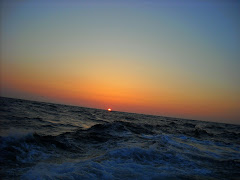I can tell you the first person who knew in his guts that something in this economy was terribly, terribly wrong.
He was slumped over the wheel on I-80, stuck in a gridlock, halfway into the two hour daily lemming run into the city.
All around him, far as the eye could see, were people just like him. Blinking in traffic next to empty latte cups, idling away gas they couldn't afford to get to jobs they might lose, vainly trying to keep up with expanding mortgages on houses a hundred miles away from where they work. All because every single converted clothes closet in the city was going for a million bucks.
As he sat there looking over at the shadow faced driver in the lane next door, nodding, like himself, to the "Dink and Dork in the Morning Show", he must have thought:
"This can't be right. How much can one crappy apartment in San Francisco really be worth?"
Somehow, in between the "Flip This House" type TV shows and the late night no money down infomercials, we were convinced that selling real estate back and forth to each other at exponentially increasing prices qualifies as an industry. The entire ponzi scheme is based on the idea that someone even stupider than you will come along with a bigger wheelbarrow full of money and cash you out. That guy then paints the porch and waits for a bigger idiot, perhaps someone in a clown suit driving up the driveway in a shiny dumptruck full of money.
Yes, it was glorious. A balloon payment, fee encrusted, high interest, high profit gold rush--all paid for by the next guy. But if all those real estate players had no jobs, no credit ratings and no cash, then where exactly did all the money come from?
Enter woolen skinned men in tall glassy cubicles. Specifically AIG, the investment wizards to whom the US taxpayers are now handing our wallets. Only recently they liked to brag that they invented the investment vehicle by which both their fantastically wealthy clients and the banks where we all put our money made unbelievable profits on the real estate idiot chain. All you had to do is bundle up the "risky" high interest home loans (often mixed with safer stuff like your municipal bonds for schools and sewers). Then you just keep pouring money on them, kind of like gasoline on a nice toasty fire. Just put enough loose money into the hands of clowns pulling dumptrucks into the driveways of recently remodeled McMansions and the whole system works wonderfully. The money you dump onto the idiot chain comes flowing back to your investors from the unbelievably high interest rates on the loans. Meanwhile fees and consultation services and sales commissions can keep a company like AIG in the spas six months out of the year- good spas too, where young girls whip you with eucalyptus branches while they recite lines from "The Art of War".
Yes the whole system works beautifully until that last clown never comes up the driveway. You don't want to be the last idiot in the idiot chain.
Like every pyramid scheme it finally collapsed under its own weight.
If there's anything to be proud of in all this it is that we apparently suckered the entire planet in. Yep, its the biggest scam of all time.




